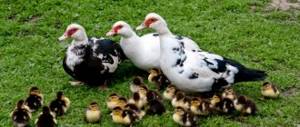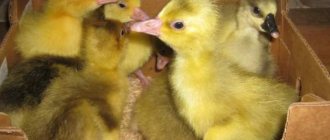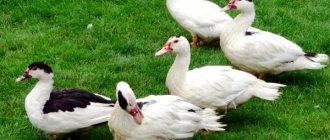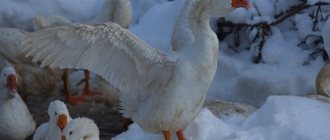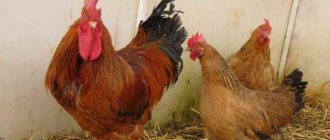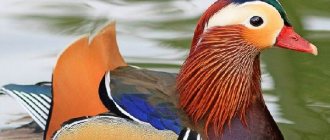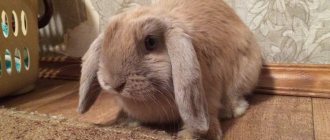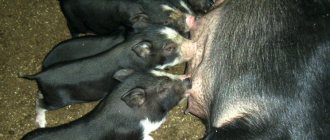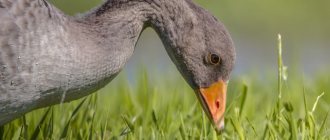Adler breed
The breed owes its name to the city where it was directly bred as a result of crossing large gray geese with two other breeds.
The birds are white in color with slight darkening, with a bright small beak and paws, have a tightly built body and a short neck. Adler geese tolerate heat well; they are bred and raised in the Krasnodar Territory.
The offspring of this breed is small by goose standards - on average 30 eggs from one goose, some of which are not fertilized, and the young have an average survival rate. This breed is also known for its unpretentiousness and lively character.
Large breeds of domestic geese
Heavy breeds are bred for maximum meat yield. Most of them are characterized by early maturity, when slaughter weight is reached after 2 months of feeding.
Toulouse
This is one of the most popular breeds, bred in France. Individuals for crossing were selected quite carefully. The result was so impressive that the Toulouse goose covered the Europeans' need for this type of meat for several centuries.
Geese of the Toulouse breed are squat, massive, and slow. When raised on specialized farms, the weight of one male reaches 11.6 kg, the average is 7 kg. Already at 2 months they weigh up to 4 kg. Usually at this age young animals are sent for slaughter: the meat during this period is tender and lean.
Toulouse geese gain weight quite quickly and do not lose it because they move little. For this reason, the meat and offal are very fatty. And one of the purposes of growing this species is the liver, which in some cases reaches 500 g. A delicacy pate is made from it.
Toulouse goose
The young are covered with soft gray down. The feathers of adults are dark gray. This indicates a relationship with wild relatives that were domesticated by humans.
There are four varieties of Toulouse geese:
- with a “purse” at the base of the head and folds on the stomach;
- only with a “wallet”;
- with folding;
- without the mentioned formations on the body.
Reference. According to the characteristics described above, Toulouse geese are distinguished between purse-bearing and purseless geese.
Toulouse goose with a “purse” under its beak
Regardless of belonging to one or another subspecies, the breed is characterized by the following characteristics:
- wide and short head;
- medium length, rather voluminous neck;
- bulky, wide body, placed horizontally.
The advantages of the breed include the following qualities:
- massive body;
- fast development;
- ease of feeding;
- fat accumulation;
- obtaining high quality fluff.
The disadvantage of the breed is that females make poor hens; their maternal instinct is weak. Therefore, the offspring are bred in incubators. Of all the eggs, only half are viable. Not all of the young survive, only 60%.
Toulouse geese are bad hens
Prices for an ovoscope for diagnosing eggs
Ovoscope
To get tasty meat, you should take care of keeping geese, especially in harsh climates. The fact is that the breed does not tolerate temperature changes and abundance of precipitation. In winter, these Toulouse dogs should not be allowed out for walking, so that they do not become hypothermic and get sick.
Kholmogorskaya
Kholmogory geese are one of the most ancient breeds in Russia. It was bred by the villagers themselves, without the participation of scientists. They were faced with the task of obtaining poultry with the greatest weight, adapting to very difficult climatic conditions. Kholmogory really turned out to be hardy, with good immunity, quickly adapting to the weather, and at the same time not losing productivity. Until recently, it was believed that the breed was lost. However, enthusiasts and professional breeders have revived this type of poultry.
Until recently, Kholmogory geese were considered a lost breed
An adult gander gains weight up to 12 kg. The female grows up to 8 kg and produces up to 30 eggs per year, each weighing about 200 g. The birds quickly reach a slaughter weight of 4.5 kg.
The breed standards are:
- strong physique;
- horizontal positioning of the body;
- long, straight back;
- two folds on the abdominal part of the body;
- fold below the beak;
- rounded, wide sternum.
Kholmogors have a curved beak and an orange bump on their forehead. The beak is orange-yellow, the metatarsals are red-yellow.
Kholmogory geese have a crooked beak and a bump on their forehead
Kholmogory geese easily tolerate temperature changes if the correct conditions are created. Any room for a poultry house is suitable. The main condition is dryness and cleanliness, good ventilation. For 1 sq. m room should contain 1 individual.
Attention! Drafts should not be allowed indoors, as this is dangerous for the well-being and productivity of geese.
The advantages of Kholmogory include:
- fast growth;
- resistance to typical geese pathologies;
- unpretentiousness to growing conditions;
- tender meat;
- high quality down and feathers;
- females have maternal instinct;
- calm disposition;
- pasture maintenance.
But the variety also has negative qualities:
- small clutch of eggs;
- The hens, due to their weight, crush the eggs with their weight.
The herd is composed of one male for four geese
Breeders who have paid attention to this breed should take into account that in the herd there should be 4 geese per gander. Females will need to be trained to lay eggs in the nest. To incubate the eggs, a female is chosen that will not leave the clutch even under stress.
Mamut
These geese are considered one of the most picky and easy to breed. They have tasty meat, of which you can get quite a lot from a carcass. This is one of the largest known breeds: the male weighs up to 13 kg, the female - up to 10 kg.
Mamuts were bred in Denmark. They were the result of crossing breeds such as Toulouse Gray and Landish White. Danish legart also participated in the breeding. The bird was brought to Russia in 1996.
Mamut is a real giant among geese
Attention! The breed has not yet been registered in Russia, and it is considered only a variety.
The breed has the following characteristics:
- white feather;
- high-set beak with white tip;
- good neck length;
- bulky yellow limbs;
- oval shaped body;
- fat folds form between the legs;
- blue eyes.
Attention! Mamut is similar to the Lindov breed. One of the few differences between them is the knob-like protrusion above the beak of the second one.
Females produce up to 50 white eggs per year, each weighing 170–210 g. The survival rate of offspring reaches 85%. Geese begin to hatch eggs as early as six months of age.
Mamuts do not tolerate prolonged confinement in enclosed spaces; they become restless and their nervous system suffers.
Mamuts need free range
These are noisy birds. They are able to protect their herd well. If males see that there is danger from another animal or person, they rush into battle and pinch painfully.
With the onset of warmth and until frost, the geese live in a light enclosure, shaded by a canopy from the sun and precipitation. They need a moat with water and a lawn with dense vegetation nearby. Mamut does not need a lot of space: 2-3 individuals get along per 1 square meter. m. poultry house.
Mamut geese also have a poorly developed brooding instinct. Therefore, it is necessary to monitor their behavior. If the eggs get cold, the future offspring will die.
Breeders note the following advantages of the breed:
- rapid weight gain;
- good egg production;
- survival rate of young animals from 82%;
- feed consumption up to a hundredweight per year, if independent grazing is available;
- ease of care;
- tender meat;
- valuable fluff;
- strong immunity.
The disadvantages include the high cost of the bird, noisy behavior, and the unsuitability of females for incubating eggs.
Conditions for incubating goose eggs
Linda (Gorkovsky)
Gorky geese are very popular in Russia: about half of poultry farmers prefer them. And all because breeding such geese is profitable and easy. Their meat is highly valued; it has an even layer of fat throughout the carcass. The protein content exceeds 20%.
The breed was registered in 1994, although it was bred much earlier. Linda is a descendant of the Chinese, Adler lines.
Lindas are real beauties
Lindas have an attractive appearance:
- head proportional to the size of the body, quite massive;
- red-orange large beak;
- bump on a forehead;
- dark, medium-sized eyes;
- large girth, long neck;
- voluminous, with a developed muscular skeleton, oblong body;
- wide, horizontal dorsal region;
- small, low tail;
- dark orange legs widely spaced, large in size;
- color white, with beige tan, gray blotches under the wing and on the back are acceptable;
- the feather is dense, the fluff is thick, and has industrial value.
Lindovsky geese are friendly and get along with other poultry. They are active, mobile, sociable. Geese defend their mates if they see danger.
Some poultry farmers note that Lindas are completely devoid of maternal instinct. However, not all breeders share this opinion, considering the females of this breed to be excellent hens. Although there is an alternative point of view on this issue, offspring are obtained using an incubator. The survival rate of offspring reaches 90%.
Goslings are hatched using an incubator
Prices for egg incubators
Egg incubators
The average weight of ganders is about 8 kg, although some individuals grow up to 12 kg. Geese gain weight up to 7 kg. This is a fast-ripening meat breed: three-month-old young animals gain half their adult weight. Egg production in females begins at the earliest at 8 months. The mass of eggs of adult females reaches 170 g.
To keep Lindov geese, a room measuring 1 square meter is required. m/individual. The required temperature in the cold season is about 10 °C. The bird quickly gets used to negative temperatures. The breed requires free walking and water bathing.
The main advantages of Gorky geese:
- rapid weight gain that does not fade even after a period of molting;
- excellent taste and high nutritional value of meat;
- the liver is used for foie gras;
- adaptability to frost and heat;
- good level of protective forces;
- significant survival rate of young individuals;
- flexible character.
Foie gras is prepared from Linda's liver
Among the disadvantages, poultry farmers note:
- failure of females to incubate eggs;
- noisiness;
- tendency to vitamin deficiencies, especially in spring;
- the need for a large yard for walking.
Vladimir clay rock
Unlike the previous one, this breed of geese received its name not only due to the city of breeding, but also due to its color. These geese are covered with light brown-gray feathers of varying intensities. The beak and paws are dark brown, massive, like the birds themselves.
Clay geese are known for their excellent feathers and meat; they are unpretentious and have strong immunity.
In one clutch there are up to 40-45 eggs, of which only about 20 become chickens. The high survival rate of young geese compensates for the low incubation period.
Demidov geese
Demidov geese are bred in the Smolensk region in the district of the same name.
This breed is distinguished by its large size, powerful paws and beak, massive body, and these birds have a fairly large wingspan.
On average, this breed produces 70 eggs per year, and the survival rate is high.
Krasnoozersk geese
The breed was developed in the Novosibirsk region as a result of crossing geese of the Lindov breed with a number of others.
The birds, like many other geese, have completely white plumage. The Krasnoozersk breed is distinguished by its long graceful neck, small thin beak and a characteristic small growth on the forehead.
One clutch may contain about 50 eggs; according to average indicators, almost all of them will later turn into adults.
Nutrition
Depending on the time of year and the purpose of raising geese, their nutrition is adjusted.
In the spring-summer season, the birds are on natural feeding with supplementary food. This means that in the warm season, the flock grazes in a meadow or in a special area previously sown with forage grass. The following are used as feed:
- root vegetables (pre-chopped);
- cake;
- bran;
- fish dust;
- legumes and cereals;
In the autumn-winter season, the diet is slightly different. Fresh grass from pastures is replaced with dry food. It comes in 2 main types: twig and grass. Root vegetables are also included in the diet, but in boiled form.
As in the summer season, soaked bran, legumes and cereal additives remain. Among the cereals for food, geese can eat barley, corn, oats and millet. Birds must consume vitamin mixtures, chalk and gravel.
At any time of the year, the flock should have enough fresh drinking water. As a healthy addition to the diet, you can use fresh or dry duckweed, salt, yeast and meat and bone meal.
As for feeding geese in industrial conditions, modern poultry farming uses dry food. This diet is balanced and contains all the necessary elements. Specific norms of food consumption per individual are shown in the table:
| Age | Dry food, g. | Combined feeding | |
| concentrated feed, g. | succulent food and greens, | ||
| Adult | 330 | 220 | 500 |
| Goslings aged, days | |||
| 1-5 | 35 | 18 | 30 |
| 6-10 | 90 | 40 | 50 |
| 11-20 | 110 | 50 | 100 |
| 21-30 | 220 | 12 | 20 |
| 31-40 | 280 | 140 | 300 |
| 41-50 | 328 | 160 | 400 |
| 51-60 | 338 | 180 | from 500 or more |
| Replacement goslings aged, days | |||
| 60-240 | 260 | 180 | no limits |
If the farm is small, then it would be advisable to use a combined feeding method. This means that the geese receive both grain (concentrated) feed and succulent feed.
Goslings are raised either for meat or to replenish the parent flock (such individuals are called replacements)
Feeding goslings is especially important
In the first 7 days after hatching, they should consume a mixture consisting of corn, wheat, cottage cheese, finely chopped eggs and sunflower or soybean meal.
Boiled root vegetables and a wet mixture of cake are introduced from the 8th day of life of the young animals. Further, as the individual grows, grain feed is gradually introduced. This happens when the goslings are already a little stronger and can eat dry food without the risk of suffocation.
Kuban breed
As a result of crossing Chinese and Linda geese in the Kuban, a new breed was developed that has a list of good characteristics.
Geese of this breed are not large in size and massive; they have dark brown feathers with a gray tint and a dark stripe on the head. The beak is small and dark, the paws are dark orange.
- Domestic goose - tips for beginners on the care and maintenance of birds (video + 90 photos)
- Treatment of goslings - the main types of diseases and their treatment at home. Recommendations from veterinarians for disease prevention (115 photos + video)
Domestic goslings - conditions of keeping, rearing and care rules. Breeding tips for beginners (100 photos and videos)
Kuban geese are known not only for their aggressiveness and tough temperament, but also for their unpretentiousness and high hatchability rates: geese lay up to 90 eggs, most of which successfully pass through all stages of development to adulthood.
Features of maintenance and care
How to properly equip a poultry house
A poultry house for large gray geese can be made from any building material: boards, bricks, cinder blocks.
The floors in the goose barn should be raised 30 centimeters above the ground. An air “cushion” is necessary to prevent the birds’ paws from freezing in winter. If you are equipping a finished room, you can simply make a second flooring.
There is no need to provide heating; it is enough to insulate the room, and in severe frosts, install an electric battery. Representatives of the gray large breed tolerate cold well.
It is necessary to make windows to improve ventilation in the room. Dampness is the main enemy of greylag geese, negatively affecting their well-being.
In the poultry house you need to equip drinking bowls and containers where you will put different types of feed. When they become dirty, they must be washed in a soda solution. You will find more information in the article “About feeders and drinkers for geese.”
Litter features
Any material will serve as bedding for large gray geese: peat, silt, sand or straw. For the winter, material must be stored at the rate of 40 kilograms per bird.
There is no consensus on the use of sawdust as bedding. Some poultry farmers believe that this is acceptable, while others are sure that such flooring is dangerous. There is an opinion that sawdust, getting into the esophagus of geese along with food, can cause various disturbances in the digestive system and, as a result, the death of the bird.
This breed will withstand frost only if the house is dry. Therefore, in winter, wet litter must be replaced with new one. When moisture from it gets on the feathers, they stop retaining heat, and the geese can freeze.
It is advisable to treat the litter once a week. Use, for example, superphosphate: 0.2 kilograms per square meter. This will help dry the flooring and minimize the release of ammonia from bird waste. And by spring you will receive wonderful fertilizer for your garden plot.
Walk
In the warm season, it is advisable to send a flock of large gray geese for walking in places where there is a lot of greenery. In summer, plant foods form the basis of their diet.
Birds can be left unattended in a fenced pasture. If we are talking about free range, then they need to be grazed. Representatives of the large gray breed are very active, and if left uncontrolled they can go far.
To avoid intestinal infections and heatstroke, do not graze your flock near a polluted body of water or in the sun.
Vaccinations and documents
Large gray geese rarely get sick. Nevertheless, birds must be vaccinated and periodically shown to a veterinarian. In addition, without a doctor it is impossible to obtain the appropriate documents for purebred pets.
These activities will reduce risks and give you the right to sell goose meat, feathers and down.
Wing clipping
Of course, domestic geese cannot fly like their wild relatives. But birds of this breed are able to rise three meters above the ground and fly about 0.5 kilometers. In some cases, this is enough for the breeder to lose his herd.
It is better not to take risks and clip the birds’ wings so that they do not disappear in an unknown direction. You can learn how to do this correctly using the example of the article “How to properly trim a duck’s wings.” The information is also relevant for geese.
What to feed
In summer, geese of this breed find their own food and need to be fed only in the evenings. Bean and cereal silage, as well as compound feed, are perfect for these purposes.
Birds can be given overripe vegetables from the garden. You don’t even have to cut them - the geese themselves will crumble even huge “woody” zucchini.
Birds will gain weight faster if they are given mineral supplements and corn.
During the cold season, the herd needs three full meals a day. Geese need to be given compound feed, grain, root vegetables and cabbage leaves. Do not allow water to stagnate in drinking bowls. It must be clean and fresh.
If you do not provide the birds with high-quality food in winter, the geese will stop laying eggs or will produce eggs that are unsuitable for hatching chicks.
Obroshinskaya breed
This breed was bred in Ukraine in the farm of the same name in the middle of the last century by crossing a number of local breeds.
The birds are distinguished by beautiful smoky-gray feathers with a wavy pattern on the back of the neck, reddish-pink legs and a small light beak, tightly packed with a small body and neck.
Obroshinsky geese are known for their vitality and resistance to various conditions and temperatures.
One clutch can reach approximately 45 eggs with a high survival rate and an even higher fertilization rate.
Collecting eggs for hatching goslings
Eggs are collected as quickly as possible, preferably while still warm, since waterfowl can heavily contaminate the shell with their paws. In addition, cooling eggs draw in surrounding air, forming an air chamber. Air entering through the pores of the shell may contain bacteria or fungi, which will subsequently lead to the death of the embryo. To ensure timely collection, nests are checked several times a day.
Immediately after collection, hatching eggs are laid horizontally in a clean, dry room, kept at a temperature of 12-13 °C. The maximum shelf life of goose eggs is 15 days. The fresher the eggs placed for incubation were, the higher the percentage of hatchability of the young will be.
When storing eggs for up to 10 days, hatchability reaches 85%; when storing eggs for up to 15 days, hatchability decreases to 45-75%.
Suitable for hatching are oval, even eggs with a smooth matte surface, without tubercles, damage, or limescale deposits. Quality is checked by transillumination using an ovoscope or a self-made device made from a flashlight or lamp and a cardboard cylinder or tube.
In the light, approximately in the center of the egg, a clean yolk is observed; there should be no inclusions of dark or red color or spots.
If necessary, wash the contaminated surface in a slightly pink solution of potassium permanganate or remove dirt using hydrogen peroxide. Before doing this, it is advisable to moisten the shell with warm water; after washing, the surface is soaked with a soft cloth.
A good way to disinfect shells at home and increase the vitamin D content is to use irradiation with a mercury-quartz lamp. The device is placed at a distance of 40 cm and the eggs are irradiated for 10 minutes on one side and 10 minutes on the other side.
Pskov bald geese
In the 19th century, a new breed with a beautiful gray-gray color was developed in the Pskov region. Pskov Balds are distinguished by a wide body, a curved light small beak and powerful paws.
Geese Linda: description, maintenance, breeding and main characteristics of the breed (85 photos + video)What to feed goslings - instructions for beginners on how to properly feed chicks at home
Diseases of geese - causes, main symptoms and methods of treatment. Fight and prevention against the most dangerous diseases (105 photos)
Compared to other geese of this breed, they lay a minimal number of eggs in a clutch, which also have a low birth rate. But on the other hand, these geese are quite hardy and easily adapt to new conditions.

